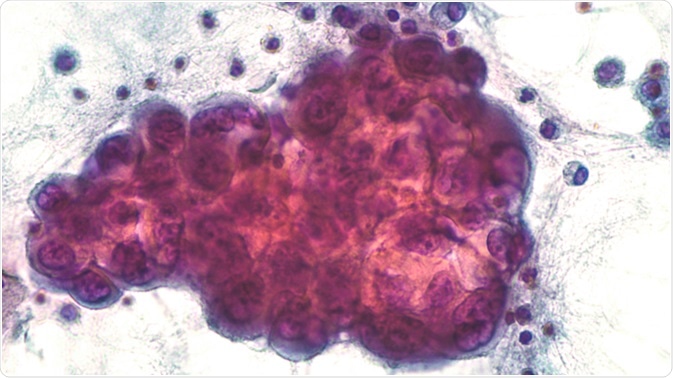
Lung Cancer and Electrolyte Imbalances
Written by Dr Tomislav Meštrović, MD, PhD., reviewed by Lois Zoppi, BA.
Patients with malignant diseases often experience imbalances in serum electrolytes, which include hyponatremia, hypokalemia/hyperkalemia, hypercalcemia and hypophosphatemia.
In many instances, the causes of such disturbances are joint etiologies that are not unique to certain cancer types. Nonetheless, these electrolyte imbalances may also signal the existence of paraneoplastic processes and foreshadow a dire prognosis.
Moreover, the development of electrolyte abnormalities is frequently associated with symptoms that negatively affects the quality of life and, in turn, prevents the action of certain chemotherapeutic agents.
Among the malignancies, lung cancer is considered the leading cause of cancer-related death around the globe. The two major types are small-cell lung cancer (abbreviated as SCLC) and non-small-cell lung cancer (abbreviated as NSCLC). The former condition is especially prone to give rise to electrolyte imbalances.

Malignant effusion: Pleural fluid pathology (cytology) of lung (pulmonary) adenocarcinoma, a type of non small cell cancer (carcinoma). Pap stain. Image Credit: David Litman / Shutterstock
Hyponatremia in Lung Cancer
Hyponatremia (i.e.low blood sodium levels) is the most common electrolyte imbalance disorder found in lung cancer patients. This condition can be related to a plethora of causes, including concurrent diseases, incidental medications, side effects of antineoplastic therapy regimens, or the disease itself.
Albeit not always life-threatening, it may often be associated with extended hospitalization, hold-ups in scheduled chemotherapy, aggravated patient performance status, negative treatment response and diminished quality of life as well as lower survival rates.
Hyponatremia is often seen in small-cell lung cancer, usually related to the syndrome of inadequate secretion of antidiuretic hormone (SIADH). It is basically a dilution example of low blood sodium linked to increased renal water retention. Conversely, only a handful of studies specifically focus on hyponatremia in non-small-cell lung cancer patients.
A recent study that examined the use of carboplatin in non-small-cell lung cancer found that it is significantly associated with the development of hyponatremia. The mechanism could be explained by uncontrolled water ingestion and decreased concentrations of serum electrolyte.
In any case, treatment of hyponatremia has to be personalized and based on both the duration and severity of sodium serum reduction, underlying etiology and extracellular fluid volume. All the available literature data show that early correction of concentration levels is of utmost importance.
The main options to achieve that goal are hypertonic or isotonic saline, fluid restriction, loop diuretics, urea and tolvaptan (vasopressin receptor 2 antagonist). For many patients with cancer-related SIADH, the hyponatremia can be refractory to therapy, thus other therapeutic venues must be explored.
Other Electrolyte Disturbances in Lung Cancer Patients
Hypokalemia is the second most frequent electrolyte imbalance seen in patients with malignant diseases. In small-cell lung cancer, amongst the important causes of low potassium levels in blood are adrenocorticotrophic hormone (ACTH)-secreting tumors.
Ectopic Cushing’s syndrome, secondary to lung cancer, is a rare occurrence with poor prognosis, but it may manifest with severe hypokalemia (alongside hyperglycemia and muscle weakness). A proper control of severe hypercortisolism prior to administering systemic chemotherapy may result in prolonged survival. Furthermore, squamous-cell carcinomas in the lung have been reported to result in hypercalcemia by means of parathyroid hormone-related protein (PTHrP) release. Although considerably less frequent, neoplasms of pulmonary origin can also make parathyroid hormone themselves.
Small molecular-targeted medical drugs that are increasingly being used may also exert adverse electrolyte reactions such as hypophosphatemia and hypomagnesmia. Therefore, attentive monitoring of phosphate and magnesium ions in serum (which is still often neglected) represents a key issue in these cases.
In conclusion, it is well established in medical literature that electrolyte imbalances represent an additional risk factor for patients with malignancies. A prompt recognition of electrolyte imbalances and corrective therapy is pivotal when caring for patients presenting with lung cancer.
Sources
- http://journals.sagepub.com/doi/full/10.5301/jo-n.5000004
- www.svemonline.org/wp-content/uploads/2016/02/endotips-vol-03-6.pdf
- https://bmcpulmmed.biomedcentral.com/articles/10.1186/1471-2466-13-55
- https://onlinelibrary.wiley.com/doi/pdf/10.1111/1759-7714.12403
- www.asn-online.org/.../Chapter5.pdf
- https://www.ncbi.nlm.nih.gov/pmc/articles/PMC5764155/
Further Reading
Last Updated: Aug 10, 2018






















.png)









No hay comentarios:
Publicar un comentario